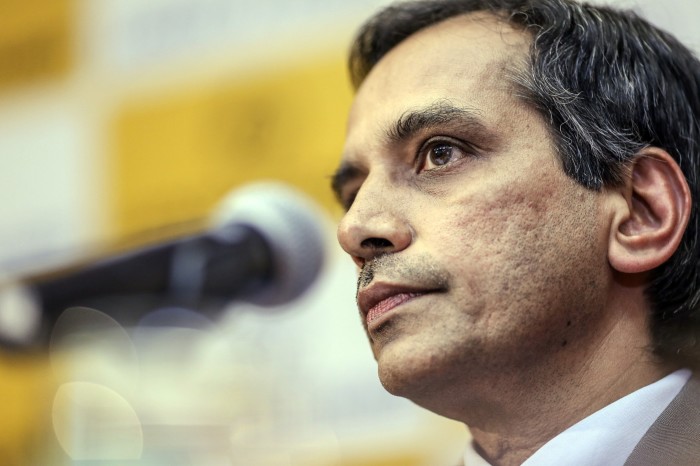
Unlock the Editor’s Digest for free
Roula Khalaf, Editor of the FT, selects her favourite stories in this weekly newsletter.
India needs to give more business to domestic private companies in defence procurement currently dominated by state-owned companies and imports, according to the chief financial officer of one of the country’s largest engineering and construction companies.
Larsen & Toubro CFO R Shankar Raman said in an interview with the Financial Times that the company’s production abilities exceeded the procurement opportunities offered by the Indian government.
The conglomerate, which generates about 5 per cent of its $27bn annual revenue from defence, recently signed deals worth hundreds of millions of dollars to help construct ships for India’s navy and supply the air force with radar equipment. It also manufactures weapons delivery and air defence systems.
“We’ve been constantly lobbying . . . saying that the government should fast-forward this whole programme,” said Raman, speaking at L&T’s headquarters in Mumbai.
“Defence infrastructure needs [an] overhaul and I think they need capable people to deliver that,” Raman said. “We do think that the capacity that we have far exceeds the opportunity we get today.”
India, flanked by hostile neighbours China and Pakistan, is the biggest importer of military hardware in the world for a wide range of kit, including fighter jets, tanks and helicopters. Russia is New Delhi’s largest arms supplier.
During the past decade, Prime Minister Narendra Modi’s administration has liberalised defence procurement and increased bidding transparency, allowing more companies to win military contracts.
But New Delhi remains reliant on over a dozen state-owned corporations, such as Hindustan Aeronautics and Bharat Electronics, which have struggled to produce a world-class defence industry and that Raman characterised as “not very efficient”.
Many large domestic conglomerates, including L&T, Adani Group and Tata Sons, have stepped in to the sector as the Modi government attempts to build out its homegrown military technology and supplies. That strategy plays into a broader “Make in India” drive to boost the country’s sluggish manufacturing.

New Delhi has to “get out of the mindset that private sector [involvement] would mean profiteering at government expense”, said Raman. “This is a big mindset change . . . we have to get the private sector to engage more.”
Analysts expect significantly more corporate participation in the industry. CRISIL Ratings, an Indian arm of S&P Global, expects the revenues of 25 private aerospace and defence companies it covers to grow 20 per cent in the fiscal year through March 2025.
“There is a lot of opportunity brewing in the background and this pipeline is not just emanating from India,” said Ankit Mehta, the chief executive of ideaForge, one of India’s biggest producers of drones that counts the country’s military as its top customer.
Mehta said the drone maker was planning to “substantially grow” their team of roughly 200 developers and has expanded in the US as it seeks new markets.
Raman said that if the government stepped up private procurement, in five years defence could represent 10 per cent of L&T’s portfolio, which includes construction, real estate and financial services.
Defence is the biggest ministerial outlay in India’s budget representing 13 per cent of central expenditure. Around $75bn was earmarked for India’s military in an interim spending plan for 2024-25 earlier this year, although much of it is allocated to salaries and pensions.
Raman said “the needs are there” for more private involvement in defence, adding the government’s ability “to deliver is limited”.